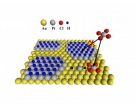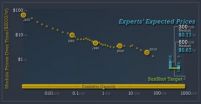(Press-News.org) Observations from 'Curiosity' when Mar's moon Phobos crosses in front of the sun, like in September, help us to understand exactly where the rover is on the red planet. Researchers at the Complutense University of Madrid (Spain) have developed a method for achieving precisely this.
The exact location of Curiosity on the surface of Mars is determined using data transmitted from its antennas as well as the space probes that orbit the red planet. It is very unlikely that these systems would fail but in such an eventuality there would be an alternative for determining the location of the rover: 'ask it' what eclipses it sees.
"Observing these events offers an independent method for determining the coordinates of Curiosity," explains Gonzalo Barderas, researcher at the Complutense University of Madrid (UCM) and coauthor of the study.
For this method to be used the robot must have a camera or sensor capable of sending data about an eclipse. "It could prove especially useful when there is no direct communication with Earth that allows for estimation of its position using radiometric dating or images provided by orbiters," outlines the researcher.
The initial objective of the UCM group was to create a mathematical tool for predicting Phobos eclipses from the surface of Mars. But their method also proved useful in locating the precise location of any spacecraft that are also capable of observing eclipses from there. The details have been published in the 'Monthly Notices of the Royal Astronomical Society' journal.
The model predicted partial eclipses that took place on the 13 and 17 September. The MastCam camera that Curiosity carries in its mast captured them without any problems. The Spanish REMS instrument, namely the vehicle's environmental station, also detected a reduction in ultraviolet solar radiation during the eclipses (5% in the first case).
The initial simulations and the real end images coincided with a precision of one second. In order to make their calculations, the scientists considered the initial predicted landing area for Curiosity: an ellipse of 7 x 20 km2.
In addition, with just two minutes of observations and using the start and end times of Phobos' contact with the Sun, error can be reduced in the rover coordinates from an order of magnitude of kilometres to another of metres.
According to the model, the next movements of the Martian moon will take place between the 13 and 20 August 2013 and between the 3 and 8 August 2014. Curiosity will have the chance to observe eclipses again and the Spanish scientists will be able to confirm the validity of their tool.
"In any case, this method can be applied to other space probes operating on the surface of Mars that have the ability to make optical observations or that have instruments that measure solar radiation," outlines Luis Vázquez, one of the authors.
In fact, under the scientific management of Vázquez, this study forms part of a Spanish project associated to the joint Russian, Spanish and Finnish MetNet mission to distribute small meteorological stations across Mars.
INFORMATION:
The project is called the Mars Environmental Instrumentation for Ground and Atmosphere (MEIGA). Its aim is to place different sensors on the red planet, including those involving solar radiation that can detect eclipses.
References:
G. Barderas, P. Romero, L. Vázquez, J. L. Vazquez-Poletti, I. M. Llorente. "Opportunities to observe solar eclipses by Phobos with the Mars Science Laboratory". Monthly Notices of the Royal Astronomical Society 426 (4): 3195-3200, October 2012. Doi: 10.1111/j.1365-2966.2012.21939.x.
'Curiosity' can be positioned with eclipses
2012-12-13
ELSE PRESS RELEASES FROM THIS DATE:
Uncovering a flaw in drug testing for chronic anxiety disorder
2012-12-13
Pre-clinical trials — the stage at which medications or therapies are tested on animals like laboratory mice — is a crucial part of drug development. It's only then that scientists can assess benefits and side effects before a drug is administered to patients.
Now, Prof. Ilan Golani of Tel Aviv University's Department of Zoology and Sagol School for Neuroscience and his fellow researchers Prof. Yoav Benjamini of TAU's Department of Statistics and Operations Research and the Sagol School of Neuroscience, and Dr. Ehud Fonio of the Weizmann Institute are questioning the ...
UAlberta medical researchers discover new potential chemotherapy
2012-12-13
Medical researchers at the University of Alberta have discovered that knocking out a particular "partner" gene is the Achilles' heel of some cancers.
Cancer causing genes often have a partner in crime, meaning when either of the two genes is active in cancer cells, the tumour grows. The challenge for researchers has been pinpointing the genes’ “lethal partners.” Loss of one of the partners alone isn’t deadly to the cell, but if both are gotten rid of, the cancer cells are destroyed.
Faculty of Medicine & Dentistry researcher Michael Weinfeld and his collaborators, ...
New technique for minimally invasive robotic kidney cancer surgery
2012-12-13
DETROIT – Urologists at Henry Ford Hospital have developed a new technique that could make minimally invasive robotic partial nephrectomy procedures the norm, rather than the exception for kidney cancer patients. The technique spares the kidney, eliminates long hospital stays and provides better outcomes by giving the surgeon more time to perform the procedure.
Dubbed ICE for Intracorporeal Cooling and Extraction, the technique may allow more kidney cancer patients to avoid conventional open surgery – now used in the vast majority of cases – and its possible complications, ...
Regenstrief study finds that generic drugs often have incorrect safety labeling
2012-12-13
INDIANAPOLIS -- Despite U.S. Food and Drug Administration regulations requiring generic medications to carry identical warnings to those on corresponding brand-name products, a study by Regenstrief Institute researchers has found that more than two-thirds of generic drugs have safety-warning labels that differ from the equivalent brand-name drug.
The investigators reviewed 9,105 product labels for over 1,500 drugs available on DailyMed, an online repository of labeling information maintained by the FDA and the National Library of Medicine. Of the 1,040 drugs with more ...
Novel NIST process is a low-cost route to ultrathin platinum films
2012-12-13
A research group at the National Institute of Standards and Technology (NIST) has developed a relatively simple, fast and effective method of depositing uniform, ultrathin layers of platinum atoms on a surface.* The new process exploits an unexpected feature of electrodeposition of platinum—if you drive the reaction much more strongly than usual, a new reaction steps in to shuts down the metal deposition process, allowing an unprecedented level of control of the film thickness.
Platinum is a widely used industrial catalyst—in automobile catalytic converters and hydrogen ...
Solar power prices to continue falling through 2025, experts say
2012-12-13
Prices for solar modules—the part of solar panels that produce electricity—will continue to fall, in line with the long-term trend since 1980, according to a survey of experts by Near Zero, , a nonprofit energy research organization. However, for prices to keep falling for the long term will require continued committment to research, such as on materials used for making solar modules.
To get a sense of what future prices for solar power are likely to be, as well as other challenges and bottlenecks that the industry faces, Near Zero conducted a formal, quantitative survey ...
Tool could help uncover bias against female faculty in STEM fields
2012-12-13
A new Northwestern University study of professors in STEM fields at top research universities across the country shows that bias against women is ingrained in the workforce, despite a societal desire to believe workplace equality exists.
The quantitative study of the complete publication records of more than 4,200 professors in seven STEM fields (science, technology, engineering and mathematics) confirms that, for some disciplines, female faculty do publish fewer papers than male faculty but not for lack of talent or effort.
The researchers found the "productivity ...
Patients with family history of colorectal cancer may be at risk for aggressive form of the disease
2012-12-13
BOSTON--When people with a family history of colorectal cancer develop the disease, their tumors often carry a molecular sign that the cancer could be life-threatening and may require aggressive treatment, Dana-Farber Cancer Institute scientists report in a new study.
The finding, reported in the Journal of the National Cancer Institute, draws on data from studies that have tracked the health of tens of thousands of people over several decades. It suggests that colorectal cancer patients could one day have their tumor tissue tested for the molecular sign, and, if necessary, ...
Targeted micro-bubbles detect artery inflammation, MU study finds
2012-12-13
COLUMBIA, Mo. — Heart disease is a leading cause of death throughout the world. Doctors say that it is important to detect heart disease early before it becomes too serious. Now, researchers at the University of Missouri have found a way that they believe could help detect heart disease before it progresses too far as well as identify patients who are at risk for strokes.
In a study published in Medicine and Science in Sports and Exercise, Isabelle Masseau, an assistant teaching professor in the MU College of Veterinary Medicine, found that she could use targeted micro-bubbles ...
Delaying childbirth may reduce risk of an aggressive form of breast cancer
2012-12-13
SEATTLE – Younger women who wait at least 15 years after their first menstrual period to give birth to their first child may reduce their risk of an aggressive form of breast cancer by up to 60 percent, according to a Fred Hutchinson Cancer Research Center study. The findings, by Christopher I. Li, M.D., Ph.D., a member of the Public Health Sciences Division at Fred Hutch, are published online in Breast Cancer Research and Treatment.
"We found that the interval between menarche and age at first live birth is inversely associated with the risk of triple-negative breast ...




